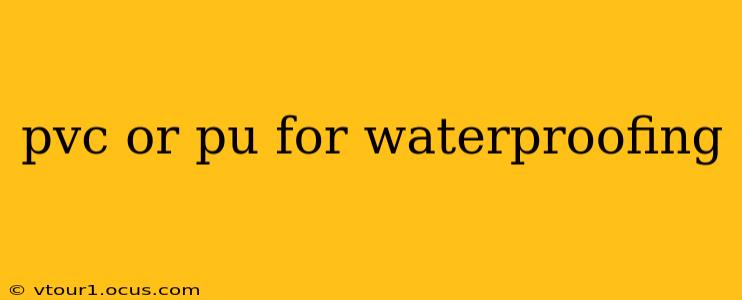Choosing the right waterproofing material is crucial for protecting your building or structure from water damage. Polyvinyl chloride (PVC) and polyurethane (PU) are two popular choices, each with its own strengths and weaknesses. This comprehensive guide will help you understand the differences between PVC and PU waterproofing membranes and determine which is best suited for your needs.
What is PVC Waterproofing?
PVC waterproofing membranes are made from flexible polyvinyl chloride sheets. They're known for their durability, resistance to UV radiation, and relatively low cost. PVC membranes are often reinforced with polyester fabric for added strength and tear resistance. They're commonly used in a variety of applications, from flat roofs to balconies and basements.
What is PU Waterproofing?
PU, or polyurethane, waterproofing is a liquid-applied membrane that cures to form a seamless, waterproof layer. This eliminates the seams and overlaps that can be weak points in sheet membranes like PVC. PU is highly elastic, allowing it to adapt to movement in the substrate, and is often chosen for its excellent bonding properties and ability to bridge cracks. It's frequently used on complex or irregularly shaped surfaces.
PVC vs PU: Key Differences
| Feature | PVC | PU |
|---|---|---|
| Application | Sheet membrane, often mechanically fixed | Liquid-applied, sprayed or brushed |
| Seams | Present, potential weak points | Seamless, eliminating weak points |
| Flexibility | Moderate | High |
| UV Resistance | Good | Excellent |
| Cost | Generally lower | Generally higher |
| Durability | High, but susceptible to punctures | High, very resistant to punctures |
| Repair | Can be patched, more complex repairs | Easier repairs, often self-healing |
| Installation | Requires skilled labor | Requires skilled labor, specialized equipment for spray application |
Which is better for flat roofs?
Both PVC and PU are suitable for flat roofs, but the choice depends on several factors. PVC offers a cost-effective solution, especially for large areas. However, PU's seamless nature and superior crack-bridging capabilities might be preferred for roofs with potential movement or existing cracks. The lifespan of both is comparable when correctly installed and maintained.
Which is better for balconies and terraces?
For balconies and terraces, PU’s flexibility and seamless nature are often advantageous. The ability to conform to the contours of the surface and bridge minor cracks makes it ideal for these areas, which can experience more movement than flat roofs. However, PVC remains a viable option, provided proper installation techniques are followed to minimize the risk of seam failure.
Which is more expensive?
Generally, PU waterproofing systems are more expensive than PVC. This is due to the higher material cost and often more complex installation process. However, the long-term benefits of PU, such as reduced maintenance and potential for a longer lifespan, may offset the initial higher cost in the long run.
Which is easier to repair?
PU is generally easier to repair than PVC. Small punctures or tears in PU can sometimes self-heal. Larger repairs are still relatively straightforward due to the seamless nature of the membrane. PVC repairs, especially larger ones, require more skilled labor and specialized patching materials.
Which lasts longer?
Both PVC and PU waterproofing systems can have a long lifespan, often exceeding 20 years with proper installation and maintenance. PU often holds a slight edge due to its seamless nature and resistance to punctures. However, the actual lifespan depends heavily on the quality of installation, substrate conditions, and environmental factors.
Conclusion
The best waterproofing material – PVC or PU – ultimately depends on your specific project requirements, budget, and the long-term maintenance you are willing to undertake. Consider the factors outlined above carefully to make an informed decision that ensures the long-term protection of your building or structure. Always consult with a qualified waterproofing professional for site-specific recommendations.
